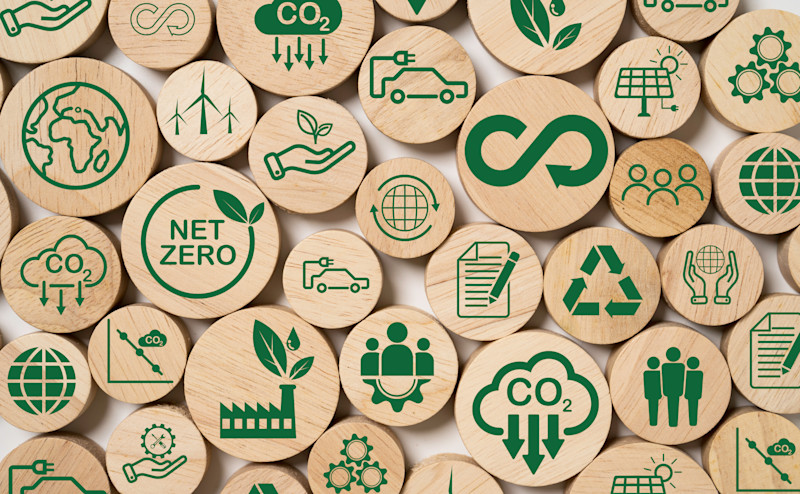The concept of sustainable manufacturing is rooted in the production of manufactured products through economically-sound processes that minimize waste, with consideration of the three ESG pillars: environment, social and governance. Reshoring has a decarbonization reduction potential of 25%-50%, eliminates human rights abuses in offshore factories, and by producing closer to markets served, creates less waste. Green powered reshoring is at the root of sustainable manufacturing, providing the optimal balance of costs and benefits.
Decarbonization sweet spot
The Reuters Impact Global Sustainability study with insight from 570 senior professionals found that energy and decarbonization was a top-three priority for organizations (84%), with 48 percent indicating it is their #1 priority. A majority of business leaders believe re-industrialization i.e. reshoring will help their organizations meet climate goals. Large EU and U.S. organizations are planning to invest $3.4 trillion over the next three years for re-industrialization.
Green powered reshoring lands squarely in the decarbonization sweet spot. Let’s dig in.
Green reshoring is the new black
I can’t stress enough the link between reshoring and sustainability. Reshoring helps organizations effectively manage environmental and social impacts.
ESG-focused reshoring serves as a catalyst for decarbonization through the reduction of long-distance transport of goods. It encourages the adoption of more environmentally friendly production processes and technologies to meet domestic environmental regulations and consumer preferences. Reshoring enables organizations to take advantage of U.S. government incentives that promote investment in low or no carbon energy sources like heat pumps and renewable energy adoption.
Reshoring fosters social responsibility through the creation of local jobs, reducing unemployment rates and positively impacting the U.S. economy. A good measure of the value society places on reshoring is the value of incentives awarded to attract manufacturing facilities. In 2023 those incentives averaged about $75,000 per employee. When you consider reshoring, calculate the number of resulting domestic in-house and supply chain jobs. Multiply by $75,000 and have a measure of the social value you are bringing to your community and country.
Local supply chains enable greater transparency to ensure compliance with ethical standards, human rights issues and fair-trade practices. And, reshoring increases U.S. innovation and R&D efforts, leading to new developments and income streams.
Reshoring reduces waste from the carrying costs of large inventories, quality/rework issues, time delays from far-flung, complex supply chains, disposal of obsolete inventory and the excessive waste from the packaging necessary for long-distance transport.
Offshoring’s dirty little secret
The negative environmental impact of offshoring packs a punch with significantly higher carbon emissions and pollution from factory production in less regulated, developing countries, more coal intensive electricity usage and long-distance maritime transport.
If shipping were considered a country, it would rank among the top-10 largest global polluters. International shipping’s greenhouse gas emissions (GHG) are 3% of the world’s total emissions and have increased by 20% over the last decade. During that decade, total global emissions only increased by 6%.
Shipping emissions are growing over 3X as fast as global emissions. Container ships collectively contribute about 140 million metric tons of carbon dioxide emissions annually, and bulk carriers about 440 million metric tons. Achieving the Reshoring Initiative’s goal of eliminating the goods trade deficit would reduce our long-distance maritime imports and resulting emissions by about 50%.
About 75% of containers arriving in the U.S. return home empty due to our trade imbalance. The emissions caused by shipping empty containers would be eliminated.
Beat the heat — produce cleaner domestically
Reshoring supply chains leads to the dramatic reduction in carbon emissions associated with manufacturing offshore, and especially in China. Scope 3 emissions — the emissions coming from supply chains and other indirect sources — represent the majority of manufacturing emissions. Reducing them has become pivotal in efforts to decarbonize.
Instead of producing cleaner domestically, the U.S. has “offshored” huge chunks of carbon pollution through the production of China-to-US exports. About 22 percent of China’s CO2 emissions are a consequence of net exports. China is the largest emitter of CO2 emissions worldwide (35% yearly total global emissions), producing about twice the emissions of the U.S.
Chinese production of goods for foreign consumption negatively impacts U.S. air quality to the tune of 12-24% of sulfate concentrations over the western United States, on a daily bases. On some days, 25% of sulfate pollution on the California coast is attributed to Chinese export production. It also contributes up to 8% of unhealthy daily mean ozone over parts of the Great Lakes region.
A Reshoring Initiative study concluded that sourcing aluminum die castings locally, instead of importing from China, reduces CO2 emissions by 25 to 50 percent. A new study by Cornell University found that US-made solar panels could cut emissions by 30%.
Incentivizing GREEN
There has been a substantial effort by the U.S. government to reduce U.S. industrial pollution and promote greener production. Efforts include President Biden’s executive order to achieve net-zero carbon emissions throughout the U.S., and direct investments from the Bipartisan Infrastructure Law of 2021 and the Inflation Reduction Act of 2022 for research and technologies to reduce manufacturing pollution.
Case in point: the Department of Energy (DOE) allocated $6 billion in funding for clean manufacturing technology projects and $100 million in grants to transform climate pollution into sustainable products.
Are you thinking about reshoring?
Reducing emissions today, as opposed to delaying the undertaking until tomorrow, requires lower capital expenditure since every year delayed in carbon reduction costs the US $150 billion in incremental costs. Are you thinking about reshoring? For help, contact me at 847-867-1144 or email me at harry.moser@reshorenow.org.






